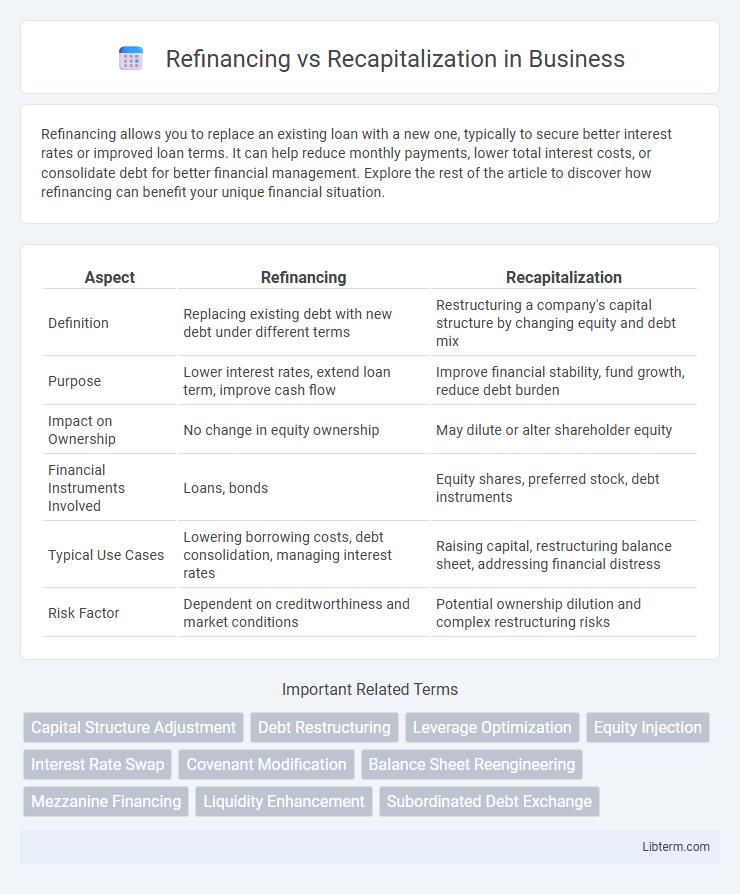Refinancing allows you to replace an existing loan with a new one, typically to secure better interest rates or improved loan terms. It can help reduce monthly payments, lower total interest costs, or consolidate debt for better financial management. Explore the rest of the article to discover how refinancing can benefit your unique financial situation.
Table of Comparison
| Aspect | Refinancing | Recapitalization |
|---|---|---|
| Definition | Replacing existing debt with new debt under different terms | Restructuring a company's capital structure by changing equity and debt mix |
| Purpose | Lower interest rates, extend loan term, improve cash flow | Improve financial stability, fund growth, reduce debt burden |
| Impact on Ownership | No change in equity ownership | May dilute or alter shareholder equity |
| Financial Instruments Involved | Loans, bonds | Equity shares, preferred stock, debt instruments |
| Typical Use Cases | Lowering borrowing costs, debt consolidation, managing interest rates | Raising capital, restructuring balance sheet, addressing financial distress |
| Risk Factor | Dependent on creditworthiness and market conditions | Potential ownership dilution and complex restructuring risks |
Understanding Refinancing: Definition and Key Concepts
Refinancing involves replacing an existing loan with a new one under different terms, typically to secure lower interest rates, reduce monthly payments, or alter the loan duration. Key concepts include interest rate adjustment, loan restructuring, and improved cash flow management, which enhance financial flexibility for individuals or businesses. Understanding refinancing helps optimize debt management by leveraging better credit conditions or capitalizing on market opportunities.
What is Recapitalization? An Overview
Recapitalization is a strategic financial restructuring process where a company changes its capital structure by altering the mix of debt and equity to improve financial stability or fund growth initiatives. This approach can involve issuing new equity, repurchasing shares, exchanging debt for equity, or taking on new debt, aiming to optimize the balance sheet and reduce the cost of capital. Unlike refinancing, which primarily involves replacing existing debt with new debt, recapitalization fundamentally transforms the company's financial foundation to better align with long-term objectives.
Major Differences Between Refinancing and Recapitalization
Refinancing involves replacing an existing debt with a new loan, usually to secure better interest rates or alter repayment terms, whereas recapitalization changes the company's capital structure by adjusting the mix of debt and equity. Refinancing primarily impacts cash flow and debt servicing costs, while recapitalization aims to strengthen the balance sheet to improve financial stability or support growth strategies. The key difference lies in refinancing's focus on debt replacement, contrasting with recapitalization's strategic shift in financing sources.
When to Consider Refinancing Your Business Debt
Refinancing your business debt is ideal when interest rates drop significantly or your credit profile has improved, enabling you to secure better loan terms and reduce monthly payments. Consider refinancing to extend loan maturity dates for improved cash flow management or to consolidate multiple debts into a single, more manageable loan. Evaluate the costs of refinancing against potential savings to determine if restructuring your debt enhances your company's financial stability and growth prospects.
Situations Best Suited for Recapitalization
Recapitalization is best suited for companies seeking to stabilize a distressed financial structure or shift their debt-to-equity ratio to improve creditworthiness and shareholder value. Businesses facing market volatility or needing to fund significant strategic initiatives often utilize recapitalization to refinance existing debt, reduce financial risk, or facilitate ownership changes without altering core operations. This approach is particularly effective for firms aiming to optimize capital structure while preserving operational flexibility and long-term sustainability.
Pros and Cons of Refinancing
Refinancing offers the advantage of lowering interest rates and monthly payments, improving cash flow and reducing overall debt costs. However, it can involve upfront fees, potential prepayment penalties, and the risk of extending the loan term, which may increase long-term interest expenses. Borrowers must weigh immediate financial relief against the possibility of higher costs over time when considering refinancing options.
Advantages and Disadvantages of Recapitalization
Recapitalization offers the advantage of improving a company's capital structure by altering the mix of debt and equity, potentially enhancing financial stability and reducing the cost of capital. However, it can dilute existing shareholders' equity and lead to increased regulatory scrutiny or transaction costs. Unlike refinancing, which primarily adjusts debt terms, recapitalization fundamentally reshapes ownership and financial leverage, impacting both control and risk profiles.
Financial Impact: Refinancing vs Recapitalization
Refinancing involves replacing existing debt with new debt, typically to reduce interest rates, extend maturities, or improve cash flow, directly impacting a company's debt service obligations and liquidity. Recapitalization restructures a company's capital structure by altering the mix of debt and equity, which can enhance financial stability, optimize cost of capital, and influence shareholder value. The financial impact of refinancing primarily affects short-term cash flow and interest expenses, while recapitalization aims at long-term balance sheet strength and strategic financial positioning.
Choosing the Right Strategy: Factors to Evaluate
Choosing the right strategy between refinancing and recapitalization depends on factors such as the company's current debt levels, interest rates, and cash flow stability. Refinancing suits businesses aiming to lower borrowing costs or extend loan maturity, while recapitalization is ideal for adjusting the capital structure to improve financial stability or fund growth. Evaluating market conditions, credit ratings, and long-term business goals is essential for making an informed decision between these financial strategies.
Real-World Case Studies: Refinancing versus Recapitalization
Real-world case studies highlight how refinancing allows companies like Tesla to lower interest rates and extend loan terms, improving cash flow without altering equity structure. In contrast, recapitalization examples such as Apple's share buyback demonstrate shifts in capital structure aimed at optimizing debt-to-equity ratios and boosting shareholder value. These strategic decisions reveal key differences: refinancing targets debt cost reduction while recapitalization focuses on adjusting the firm's overall financial leverage.
Refinancing Infographic

 libterm.com
libterm.com